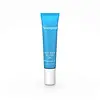What's inside
What's inside
 Key Ingredients
Key Ingredients

 Benefits
Benefits

 Concerns
Concerns

 Ingredients Side-by-side
Ingredients Side-by-side

Water
Skin ConditioningIsononyl Isononanoate
EmollientPropanediol
SolventDimethicone
EmollientArachidyl Alcohol
EmollientPhenyl Trimethicone
Skin ConditioningC12-15 Alkyl Benzoate
AntimicrobialBehenyl Alcohol
EmollientPEG-100 Stearate
Palmitoyl Glycine
CleansingButyrospermum Parkii Butter
Skin ConditioningHydrogenated Olive Oil
Skin ConditioningGlyceryl Stearate
EmollientArachidyl Glucoside
EmulsifyingPhenoxyethanol
PreservativePolysilicone-11
Caprylyl Glycol
EmollientOlea Europaea Fruit Oil
MaskingTribehenin
EmollientPanthenol
Skin ConditioningSodium Acrylate/Sodium Acryloyldimethyl Taurate Copolymer
Emulsion StabilisingGlycerin
HumectantIsohexadecane
EmollientXanthan Gum
EmulsifyingOlea Europaea Oil Unsaponifiables
Skin ConditioningCamellia Sinensis Leaf Extract
AntimicrobialDisodium EDTA
Lactobacillus Ferment Lysate
Skin ConditioningPunica Granatum Extract
AstringentPolysorbate 80
EmulsifyingCeramide Ng
Skin ConditioningPEG-10 Rapeseed Sterol
CleansingMethylglucoside Phosphate
Skin ConditioningDunaliella Salina Extract
Skin ConditioningGlucose
HumectantLactobacillus Ferment
Skin ConditioningCopper Lysinate/Prolinate
Skin ConditioningCaffeine
Skin ConditioningCitric Acid
BufferingEthylhexylglycerin
Skin ConditioningPalmitoyl Tripeptide-5
Skin ConditioningSodium Hyaluronate
HumectantAcetyl Tetrapeptide-2
Skin ConditioningPantolactone
HumectantPotassium Sorbate
PreservativePalmitoyl Hexapeptide-12
Skin ConditioningWater, Isononyl Isononanoate, Propanediol, Dimethicone, Arachidyl Alcohol, Phenyl Trimethicone, C12-15 Alkyl Benzoate, Behenyl Alcohol, PEG-100 Stearate, Palmitoyl Glycine, Butyrospermum Parkii Butter, Hydrogenated Olive Oil, Glyceryl Stearate, Arachidyl Glucoside, Phenoxyethanol, Polysilicone-11, Caprylyl Glycol, Olea Europaea Fruit Oil, Tribehenin, Panthenol, Sodium Acrylate/Sodium Acryloyldimethyl Taurate Copolymer, Glycerin, Isohexadecane, Xanthan Gum, Olea Europaea Oil Unsaponifiables, Camellia Sinensis Leaf Extract, Disodium EDTA, Lactobacillus Ferment Lysate, Punica Granatum Extract, Polysorbate 80, Ceramide Ng, PEG-10 Rapeseed Sterol, Methylglucoside Phosphate, Dunaliella Salina Extract, Glucose, Lactobacillus Ferment, Copper Lysinate/Prolinate, Caffeine, Citric Acid, Ethylhexylglycerin, Palmitoyl Tripeptide-5, Sodium Hyaluronate, Acetyl Tetrapeptide-2, Pantolactone, Potassium Sorbate, Palmitoyl Hexapeptide-12
Water
Skin ConditioningDimethicone
EmollientGlycerin
HumectantCetearyl Olivate
Sorbitan Olivate
EmulsifyingPolyacrylamide
Phenoxyethanol
PreservativeDimethicone/Vinyl Dimethicone Crosspolymer
Skin ConditioningSynthetic Beeswax
Emulsion StabilisingC13-14 Isoparaffin
EmollientDimethicone Crosspolymer
Emulsion StabilisingCarbomer
Emulsion StabilisingTrehalose
HumectantDimethiconol
EmollientChlorphenesin
AntimicrobialLaureth-7
EmulsifyingSodium Hyaluronate
HumectantEthylhexylglycerin
Skin ConditioningSodium Hydroxide
BufferingC12-14 Pareth-12
EmulsifyingWater, Dimethicone, Glycerin, Cetearyl Olivate, Sorbitan Olivate, Polyacrylamide, Phenoxyethanol, Dimethicone/Vinyl Dimethicone Crosspolymer, Synthetic Beeswax, C13-14 Isoparaffin, Dimethicone Crosspolymer, Carbomer, Trehalose, Dimethiconol, Chlorphenesin, Laureth-7, Sodium Hyaluronate, Ethylhexylglycerin, Sodium Hydroxide, C12-14 Pareth-12
 Reviews
Reviews

Ingredients Explained
These ingredients are found in both products.
Ingredients higher up in an ingredient list are typically present in a larger amount.
Dimethicone is a type of synthetic silicone created from natural materials such as quartz.
What it does:
Dimethicone comes in different viscosities:
Depending on the viscosity, dimethicone has different properties.
Ingredients lists don't always show which type is used, so we recommend reaching out to the brand if you have questions about the viscosity.
This ingredient is unlikely to cause irritation because it does not get absorbed into skin. However, people with silicone allergies should be careful about using this ingredient.
Note: Dimethicone may contribute to pilling. This is because it is not oil or water soluble, so pilling may occur when layered with products. When mixed with heavy oils in a formula, the outcome is also quite greasy.
Learn more about DimethiconeEthylhexylglycerin (we can't pronounce this either) is commonly used as a preservative and skin softener. It is derived from glyceryl.
You might see Ethylhexylglycerin often paired with other preservatives such as phenoxyethanol. Ethylhexylglycerin has been found to increase the effectiveness of these other preservatives.
Glycerin is already naturally found in your skin. It helps moisturize and protect your skin.
A study from 2016 found glycerin to be more effective as a humectant than AHAs and hyaluronic acid.
As a humectant, it helps the skin stay hydrated by pulling moisture to your skin. The low molecular weight of glycerin allows it to pull moisture into the deeper layers of your skin.
Hydrated skin improves your skin barrier; Your skin barrier helps protect against irritants and bacteria.
Glycerin has also been found to have antimicrobial and antiviral properties. Due to these properties, glycerin is often used in wound and burn treatments.
In cosmetics, glycerin is usually derived from plants such as soybean or palm. However, it can also be sourced from animals, such as tallow or animal fat.
This ingredient is organic, colorless, odorless, and non-toxic.
Glycerin is the name for this ingredient in American English. British English uses Glycerol/Glycerine.
Learn more about GlycerinPhenoxyethanol is a preservative that has germicide, antimicrobial, and aromatic properties. Studies show that phenoxyethanol can prevent microbial growth. By itself, it has a scent that is similar to that of a rose.
It's often used in formulations along with Caprylyl Glycol to preserve the shelf life of products.
Sodium Hyaluronate is hyaluronic acid's salt form. It is commonly derived from the sodium salt of hyaluronic acid.
Like hyaluronic acid, it is great at holding water and acts as a humectant. This makes it a great skin hydrating ingredient.
Sodium Hyaluronate is naturally occurring in our bodies and is mostly found in eye fluid and joints.
These are some other common types of Hyaluronic Acid:
Learn more about Sodium HyaluronateWater. It's the most common cosmetic ingredient of all. You'll usually see it at the top of ingredient lists, meaning that it makes up the largest part of the product.
So why is it so popular? Water most often acts as a solvent - this means that it helps dissolve other ingredients into the formulation.
You'll also recognize water as that liquid we all need to stay alive. If you see this, drink a glass of water. Stay hydrated!
Learn more about Water